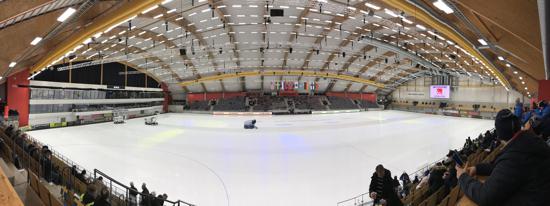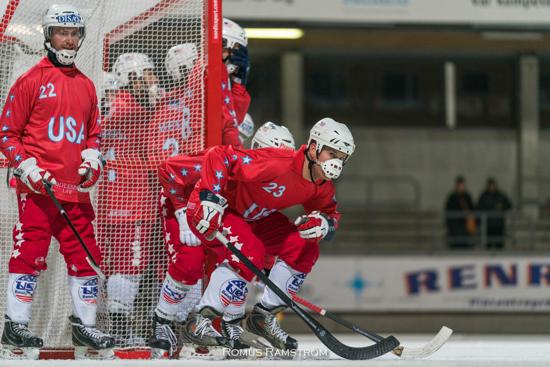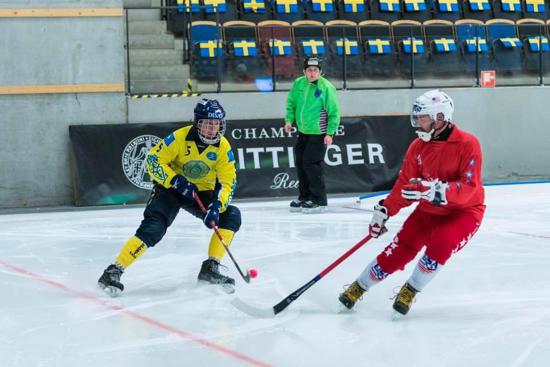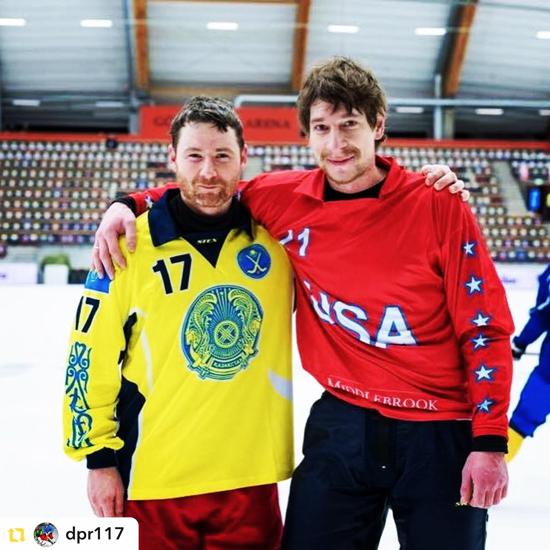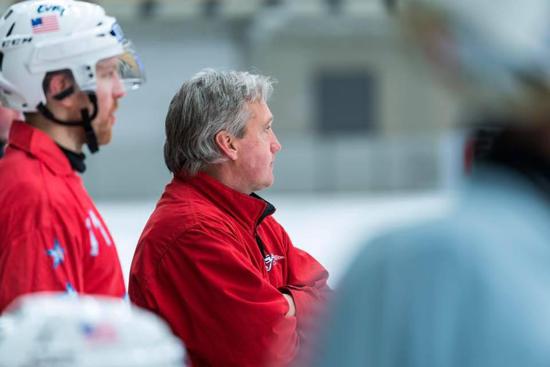
Team USA defeats Germany and Belarus for 6th Place Finish in 2017 VM in Sweden
A Recap of Team USA's 2017 Men's Bandy VM in Sandviken, Sweden
Coming off basically a rebuilding year in 2016, the 2017 USA Bandy team set their sights on moving up in the rankings for this year’s World Bandy Championships held in Sandviken, Sweden the week of January 26-February 6. After playing in various cities in Russia the last several years, the team looked forward to returning to Sweden after a four year absence. They also looked forward to playing in the new twenty million dollar Goransson Area, another addition to the growing number of indoor bandy rinks popping up all over Scandinavia and Russia. The players soon discovered that Goransson Arena was everything they had heard and was quite a luxury to play in after playing outside in all weather conditions back home.
By defeating Germany and Belarus in the round robin, Team USA 2017 finished 6th place in the world, one notch up from last year and qualified to again play in the elite A-Pool for the 2018 World Championships to be held in Khaborovsk, Russia. While these results alone can be considered a relative success, USA’s head coach Chris Halden indicated the team had a goal of beating both their arch rivals Norway and Belarus, but unfortunately this did not happen. However, given Norway’s huge upset of powerhouse Kazakhstan, Norway clearly was the real deal this year and the USA team’s loss to Norway was no reason for anyone to hang their heads. Rather, Norway’s success was a good sign both Norway and the USA are getting closer to the upper echelon teams.
After last year’s result's in Ulyanovsk, Russia, the 2017 USA team was in agreement that to move up in the standings, they needed to train hard for several months both on and off the ice which would also include facing high level competition before the tourney even started. With the aid of longtime Swedish supporter KG Jonsson, Team USA Manager Magnus Skold was able to arrange two exhibition games against Tellus and Hammarby, two teams currently playing in the Swedish elite league. The games were arranged to be played at the famous Zinkensdamm Stadium in the heart of the city, and the USA team was elated to have this kind of opportunity.
The 2017 Team USA added several new players that were excited to play in their very first world championship including Dane Erickson (Bandoliers), Jake Rossman (Golden Dragons), Joe Welch (MN Blades) and keeper Zach Wynne (Duluth Dynamo). In addition, Brett Stoplestad (Bandoliers) was making a reappearance after not playing on the team last year. These players needed to step in and fill some big holes left by several players missing from this year’s team including veterans Dave Plaunt, Scott Arundel, Mikael Sandberg, Rick Haney and keeper Derek Melander.
The dryland training program Team USA had implemented a few years ago at First Athlete in Edina by USA player Mikael Lickteig was once again implemented for twice a week training beginning in October. Under the tutelage of trainer Tim Herkenhoff, the players worked hard using training methods used by professional athletes to get into a physical condition allowing them to be able to play seven 90 minute games in just over a week. On- ice training in hockey rinks and then at the Oval was added to the mix, and after four months of training including six exhibition games against all the elite USA teams, Team USA 2017 was ready to roll.
One of the biggest dilemmas the team potentially faced was having nearly a third of the team playing in Europe and the question of how fast the team’s eleven local based players and five “Euros” could assimilate into a cohesive unit. The five Euros included Mikael Lickteig who plays in Hamar, Norway; plus Daren Richarson, Jacob Blucher, Kevin Brown and newcomer Alexander Zoutoni who all are playing on top Swedish club teams. Whether or not the team could assimilate quickly was answered in the first few minutes of the first game against Tellus, as Team USA was able to skate and compete with them right out of the gate despite barely having had time to rest from a long overseas plane flight. Fighting jet lag, Team USA quickly joined forces with the five Euro players and somehow was able to find instant team chemistry. The game see-sawed back and forth on the scoreboard but Tellus managed to pull away to an 8-5 win; however several of the USA players felt they could have won the match with a few breaks. The second exhibition game was scheduled the next day against Hammarby, a famous Swedish sports club who won the Swedish championship only a few years ago. This year’s Hammarby team is only a few notches below the top of the elite league, so Team USA knew they were facing one of the top club teams in the world. But with the strong opening performance against Tellus, they were ready. Hammarby was as slick and polished as expected, but Team USA was able to contain Hammarby’s high powered offense through most of the game, but Hammarby was finally able to take advantage of the travel weary Americans, winning 8-3. Still, the American team felt they had played a relatively strong match and competed hard against a team with much greater depth and experience.
During the Stockholm visit, the team was visited by two USA Bandy legends Tom “Cannon” Howard who is now living in Goteborg, Sweden and coaching bandy, and longtime USA player Jasper “Jappe” Felder, who is still playing in Stockholm which gave them some additional support.
With a solid experience in the two exhibition games in Stockholm, the team headed up to Sandviken, optimistic they were in much better position to play the world’s best teams than the previous year. The first game against Germany was a historic match as this was the first time USA ever played Germany in bandy. The German team was curiously full of Russian players, so to take this squad of unknowns lightly would be a mistake. Former Russian elite league players Alex Kolyagin and Mikael Dunaev posed a real threat. But the USA team was ready for this mystery team and rolled to a 9-4 victory, led by 2 goals each from Mike Carman and Mikael Lickteig.
Game #2 of the VM was against Norway and the USA team was determined to start out better than last year when they fell behind quickly. With Daren Richarson putting the USA on the board first, it looked like things might be going their way this year. Norway scored two to take the lead 2-1, but Mac Williams tied it up for the USA and it looked like the game would continue to be close. Unfortunately, Norway had other ideas as they capitalized on some mistakes by the USA early in the second half and took a 5-2 lead on goals by Nikolai Jensen and Frederik Randeborg. The USA kept fighting and got another goal from Kevin Brown, but could not close the gap and eventually lost 8-3.
With the disappointing loss to Norway, the next game against Belarus was critical. Would the USA step up or let Belarus slip away with another win as they had the last two years? Belarus got on the board first on a goal by Sergei Yusaov, but Dane Erickson countered to make it 1-1. Yuri Zenkov scored for Belarus to again take the lead 2-1 in the first 10 minutes giving the USA some anxiety, but USA's Mike Carman stepped up at the 13 minute mark to tie it up 2-2 and regain the momentum. Daren Richardson and Kevin Brown both pounded in 2 goals each to give the USA a commanding 7-2 lead. The USA team continued to keep it rolling, eventually steamrolling Belarus 14-5. Brown led the USA's scoring parade by scoring five goals and Carman had another superb game with the hat trick. Lickteig and Richardson added two each and Mac Williams and Dane Erickson one each. Keeper Gavin Ancheta was solid in the net and got the big win. This second victory in the round robin clinched the USA team’s place in the A-Pool for next year, taking off the pressure of any possible Saturday battle to stay up in the elite division with the world’s top bandy countries where the USA wants to stay.
While the win over Belarus was huge, the actual time to celebrate was short as the team had to face a very powerful Finland team in the quarterfinals the next day. Having already played five 90 minute games in six days, and about to play a group of highly skilled professionals, the team knew it was going to be a tough match. Finland indeed came out ready to take no prisoners and never let the foot off the gas, winning 15-1. Rolf Larsson, Mikko Lukkainan and Jimi Heinanen each had hat tricks for Finland demonstrating how deep their offense is. While no excuse, team USA clearly had no legs left for the match and with one game left, focused on putting the Finland game in the rearview mirror and finishing strong against Team Kazakhstan, who were upset by Norway in the quarterfinals in OT which sent shock waves through the bandy world.
With a day of rest, Team USA came ready to play against a Kazakhstan team that had won several bronze medals over the last several years and are still considered a “Big Four” team. Team USA had the confidence they could skate with the Kazakhs, therefore they did not sit back and “park the bus” but rather played them straight up and were able to battle hard and keep the score fairly close for most of the game. But the more experienced Kazakhs eventually pulled away with a late surge, winning 9-4. Despite the loss, USA played well and it was fitting the team finished strong and had the opportunity to play a top team like Kazakhstan, who they can gain some valuable experience playing against. For the USA, Daren Richarson had two goals, Lickteig one and Peter Knutson one against the Kazakhs.
Overall, the USA team was satisfied they had left nothing on the ice in VM 2017 and played as good of bandy as ever seen by a USA team in international play. USA Captain Mike Carman indicated he was happy to see how well the team recovered mentally from the loss to Finland to go head to head and finish strong against a major bandy power like Team Kazakhstan. Veteran Andrew Knutson reflected he was also pleased with how well the team played in Sweden and how well all the new players were able to jump right in and fill holes left by several vets. The addition of the smooth skating Alexander Zitouni was a big plus for Team USA, who have now added a world class defender and playmaker to the lineup. Zitouni currently play in the Swedish elite league with IFK Vanersborg and is a teammate of the world's best player and legend Sergei Lomanov, and was able to seamlessly fit right into the team’s ever evolving style of play and his team-first attitude was well received by his teammates and team leaders.
Coach Halden singled out the leadership of Captain Mike Carman and Andrew Knutson in helping get the local based players ready to go during the four month training camp period and also starting fullback Greg Olson who was also a steady influence on the young guns. This was considered a huge part of the team’s success as the eleven Minnesota based players were essentially ready to go when they hit the ground in Sweden. Kudos were also given to the five Euros for seamlessly blending into the team immediately without any friction. “The Euro guys were fantastic in the way they came in and blended right in with the guys coming over from the USA to form a close knit team in our very first game in Stockholm. I knew right then we had a solid team in the making” said Halden. Carman had a great tournament, scoring 6 goals and was a constant threat as his rushes were often like a bull in China shop and nearly every opposing coach indicated they loved his intensity. Andrew Knutson also had another solid tourney, playing every minute of every game except for penalties, and was always ready to bang the opposition down in the trenches when needed and provide the necessary outlet passes. Olson's improvement has been amazing given he has only been playing bandy a few years and has developed into one of the best fullbacks ever to wear the USA jersey.
Coach Halden also indicated veterans Daren Richardson, Mikael Lickteig, Kevin Brown and Jacob Blucher also had a great tournament and provided a rock solid, reliable base from which to build the team around. As usual, Richardson was the team’s main engine and got the team’s offense going, and some of the stickhandling moves he pulled off every game were nothing short of spectacular. Licktieg had another great VM tourney, netting five goals, but Halden indicated his value as a defensive forward was also a big key in the team’s success as his relentless hustle kept the other team’s breakout plays off balance. "He's really become a great two-way player" said Halden. Brown led the team in scoring with 7 goals, with an eye- opening five goals in the big win over Belarus. Blucher played hard-nosed defensive midfield and was also not shy about bouncing players along the boards. The new players also stepped up and contributed immediately. Rookie fullback Joe Welch started every game at fullback and his aggressive play and speed was very effective for defending against some of the fastest skaters in the world, and his rushing ability added a new dimension to the defense. Dane Erickson got better each game and filled in at in at multiple positions and scored a beautiful goal against Belarus. Rookie Jake Rossman was able to shake off a severe ankle injury right before the tourney and play smart, efficient bandy at forward and midfield and got a huge assist against Belarus. Forward Mac Williams pumped in two goals and his constant hustle was effective for steering. Wyatt Wenzel and Peter Knutson logged huge minutes at halfback and Knutson’s goal against Kazakhstan was a highlight reel goal and a put a nice stamp on a great tourney. Wenzel played in his 5th VM and logged iron-man minutes at halfback, averaging about 80 minutes a game and has established himself at the tough halfback position. Libero Greg Olson was his usual steady self, gobbling up air balls and along with Joe Welch and Andrew Knutson, the fullback line was able to turn aside rush after rush against some of the most skilled players in the world. Keepers Gavin Ancheta and rookie Zach Wynne both played solid while facing a blitz of shots every game, making several huge saves, especially on the many corners the team faced every game. Wynne was playing in this VM after a crash course in bandy goaltending that started only last October and was up to the task, playing big minutes and gaining valuable experience.
Since it was a total team effort this year, Technical Director John Hedenstrom must also be mentioned for his big contributions to the team’s success as he had all the player’s skates in perfect form each game as well as being ready for emergency sharpening in the middle of games. Richardson said he thinks Hedenstrom is the best at what he does in the world. Also, the leadership and guidance provided by Team Leader Chris Middlebrook from the first day of training camp to the final game was also a huge part of the team’s success and now that “Brooker” has retired from his job as a lawyer, it is hoped that he can continue to lead the USA bandy program as he has for over 30 years. Mikael Sandberg’s assistance in training camp in developing strategy also contributed to the team’s success.
Another VM has come and gone, and looking back, Team USA proved in the 2017 VM that they are on the right track as they moved up a notch to in the world standings this year and are optimistic they can continue to improve and play high level bandy with the world’s best teams. The USA players are already excited for next year’s return to Russia. See you in Khaborovsk!
Tag(s): Home
